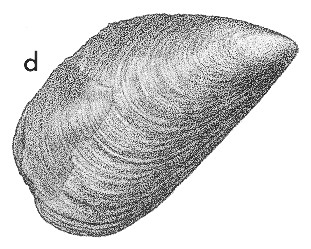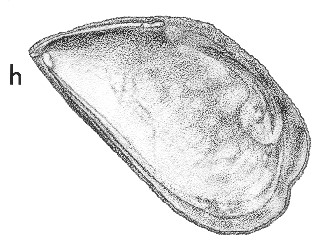
Revised descriptions of New Zealand Cenozoic Mollusca from Beu and Maxwell (1990)

 | Revised descriptions of New Zealand Cenozoic Mollusca from Beu and Maxwell (1990) | 
|
  (Pl. 45d): GS12290, E38/f15, Teer Creek fauna (Castlecliffian, oxygen isotope stage 25?), beneath Cascade Moraine, north side of Cascade Point, South Westland, Haweran (GNS) |
  (Pl. 45h): GS12290, E38/f15, Teer Creek fauna (Castlecliffian, oxygen isotope stage 25?), beneath Cascade Moraine, north side of Cascade Point, South Westland, Haweran (GNS) |
Beu & Maxwell (1990): Chapter 16; p. 340; pl. 45 d,h.
Synonymy: Mytilus galloprovincialis Lamarck 1819, p. 126; Mytilus edulis (not of Linné) of Suter 1913c, p. 86; M. planulatus (not of Lamarck) of Oliver 1923, p. 181; M. aoteanus Powell 1958, p. 87; Mytilus edulis aoteanus, Beu & Maxwell 1990, p. 340, pl. 45d, h; M. galloprovincialis, Hilbish et al. 2000; Beu 2004, p. 147; Gardner 2004.
Classification: Mytilidae: Mytilinae
Description: Moderate-sized for family (to 100 mm long; a few specimens to 150 mm), with narrowly pointed anterior, terminal umbones, straight ventral margin, strongly convex dorsal margin, and evenly rounded posterior; smooth except for weak growth ridges. White (aragonitic) internal layer ending at obvious pallial line; adductor scar postero-dorsal, long, narrow; white ligamental scar along anterior third of dorsal margin; weak, short teeth and grooves below umbo. Calcitic outer shell layer thick, remaining deep, bright blue in young fossils, black in older fossils.
Comparison: The taxonomy, variation, genetics and distribution of the smooth-shelled "blue mussels" of the genus Mytilus have been studied more thoroughly than almosy any other molluscs, because of their economic importance, their complications and their genetic oddities (such as male inheritance of mitochondrial genes). The most recent account (Gérard et al., 2008) recognised three species that have now become reasonably well accepted: M. edulis Linnaeus, 1758, North Atlantic (Norway to Britain, E USA); M. trossulus Gould, 1850, boreal regions (NE and NW North America, Baltic Sea, Bering Sea to N Japan); and M. galloprovincialis Lamarck, 1819, Mediterranean-E Atlantic, California, & NW Pacific (China to N Japan). In several areas, 2-3 species occur together in the northern hemisphere, maintaining their identities except for narrow hybridising zones. "Mixtures" of these three species (Hilbish et al. 2000) also occur around all southern land-masses, and it is the identity of these that has provided the greatest puzzle. Gardner (2004) confirmed that the New Zealand shells fall into M. galloprovincialis, although Daguin & Borsa (2000) suggested that Australian and New Zealand specimens should be recognised as a geographical subspecies of M. galloprovincialis. Gérard et al. (2008) suggested that their genetic composition indicated that the Australian-New Zealand population crossed the equator from the northern hemisphere before M. galloprovincialis and M. trossulus separated, and is literally a mixture of the genetic composition of these two species. The mix of human transport of mussels (apparently responsible for the Californian population of M. galloprovincialis) and the geologically recent separation of species makes this a complex group to interpret in terms of the standard definition of species, but Gardner's (2004) demonstration that New Zealand specimens fall into M. galloprovincialis is followed here.
Distribution: Castlecliffian-Recent; Recent, New Zealand (type of M. aoteanus). Mytilus galloprovincialis (the common "blue mussel") lives now in dense mats byssally attached to intertidal rocks only, and so occurs commonly as a fossil only in the shallow-water faunules of late Pleistocene terraces ("raised beaches"). The earliest record we are aware of is Castlecliffian (Teer Formation, Cascade Point, S Westland, about oxygen isotope stage 25, 1 valve, illustrated), but the fragile nature of fossil shells makes the early history poorly known. The genus seems to have arrived in New Zealand about 1.5 m yrs ago, from this evidence.
Cite this publication as: "A.G. Beu and J.I. Raine (2009). Revised
descriptions of New Zealand Cenozoic Mollusca from Beu and Maxwell (1990). GNS
Science miscellaneous series no. 27."
© GNS Science, 2009
ISBN
978-0-478-19705-1
ISSN 1177-2441
(Included with a PDF facsimile file
copy of New Zealand Geological Survey Paleontological Bulletin 58 in CD version
from: Publications Officer, GNS Science, P.O. Box 30368 Lower Hutt, New
Zealand)